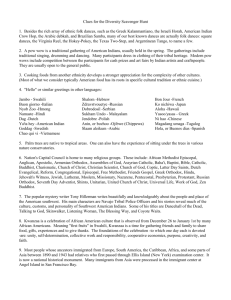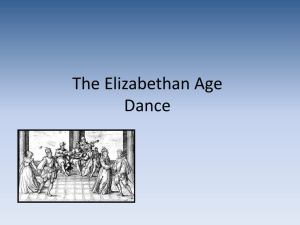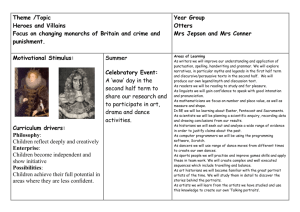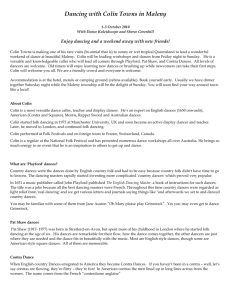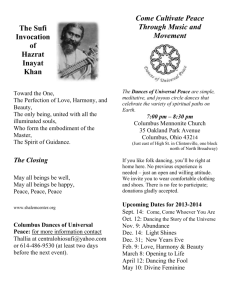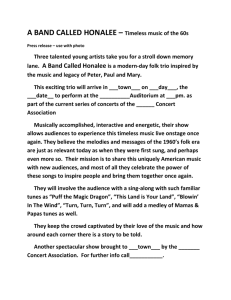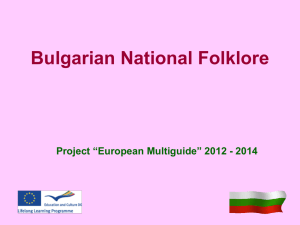Folk Dances of the United States: Regional Types and Origins
advertisement
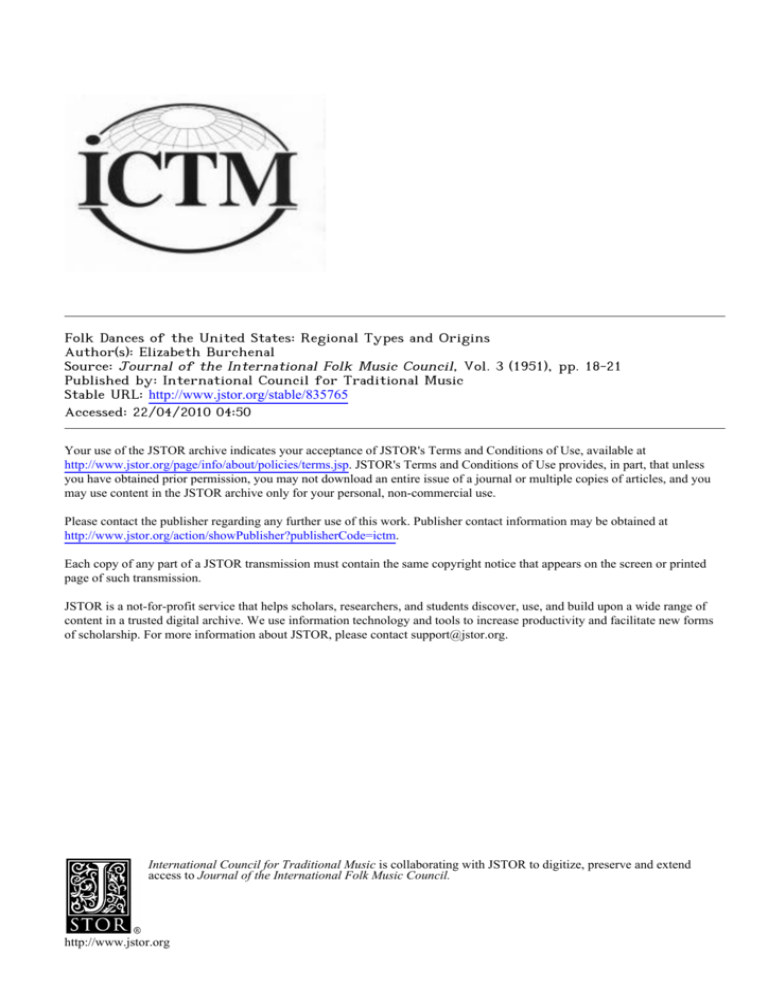
Folk Dances of the United States: Regional Types and Origins Author(s): Elizabeth Burchenal Source: Journal of the International Folk Music Council, Vol. 3 (1951), pp. 18-21 Published by: International Council for Traditional Music Stable URL: http://www.jstor.org/stable/835765 Accessed: 22/04/2010 04:50 Your use of the JSTOR archive indicates your acceptance of JSTOR's Terms and Conditions of Use, available at http://www.jstor.org/page/info/about/policies/terms.jsp. JSTOR's Terms and Conditions of Use provides, in part, that unless you have obtained prior permission, you may not download an entire issue of a journal or multiple copies of articles, and you may use content in the JSTOR archive only for your personal, non-commercial use. Please contact the publisher regarding any further use of this work. Publisher contact information may be obtained at http://www.jstor.org/action/showPublisher?publisherCode=ictm. Each copy of any part of a JSTOR transmission must contain the same copyright notice that appears on the screen or printed page of such transmission. JSTOR is a not-for-profit service that helps scholars, researchers, and students discover, use, and build upon a wide range of content in a trusted digital archive. We use information technology and tools to increase productivity and facilitate new forms of scholarship. For more information about JSTOR, please contact support@jstor.org. International Council for Traditional Music is collaborating with JSTOR to digitize, preserve and extend access to Journal of the International Folk Music Council. http://www.jstor.org INTERNATIONAL FOLK MUSIC JOURNAL TUESDAY, JULY I8TH (AFTERNOON SESSION) Chairman: DR. PAUL NETTL (Indiana University) FOLK DANCES OF THE UNllT'ED STATES: REGIONAL TYPES AND ORIGINS by ELIZABETH BURCHENAL (New York) term "folk dance" as used here does not refer to "populardance" or to "revivals" but rather to "authentic" folk dance as a folk art which has been handed down through the years, from generation to generation, in a manner correspondingto "oral transmission" in the case of folk song, eventually becoming an established tradition of a people. The present study of folk dances of the United States is confined to four principal regional types which may be said to be classifiable as folk dances indigenous to and distinctive of this country, whose origins may be accounted for by investigation of the early colonisation and settling of the regions in which they are centred. These are dances, the grass roots of which were in the life and conditions of our early colonists (and later of our western pioneers and settlers) which through the years evolved into a native form and became traditional and characteristic of rural United States. There are other forms of folk dance in the United States which have not been included in this study, such as the dances of the American Indians; dances of foreign nationality communities living together and carrying on their customs here; dances infiltrating over the Mexican border; remnants of early Spanish dances in California, etc. There is also a country-wide popular revival of "square dancing" and "international folk dancing," the practice of which on a large scale by modern groups of townspeople is inevitably, sometimes purposely, causing change of its form and character, and so endangering our heritage. It is a movement similar to what is going on apace all over Europe. For obvious reasons this, too, is omitted here. The four distinctive regional types of American folk dances with which we are concerned are as follows: (I) New England Country Dances, (2) Appalachian Mountain Dances, (3) the Mid-West and Mid-South Play Party Games, and (4) the countrywide Square Dances. The tracing of the origins of these involves a study of the large grants of land made by the British Crown to individuals and to land companies for colonisation, and of the nationalities of the immigrants who came as colonists. The history of our colonisation from the early i6oo's through the I7oo's, and the ethnic pattern of the colonies, are too complex to discuss in detail here. It may be briefly stated that while the grantees were largely English, colonial recordsshow that a surprisinglylarge proportionof the colonists coming in continuous waves to the ports of Maine, Boston, Philadelphia, Norfolk, Charleston, were from Ireland and Scotland where they were easy to recruit because of religious and economic persecution, poverty, land evictions, the thirst for freedom and a new life and land of their own. High points in the colonisation which seem to give evidence of Scottish and Irish origins of our folk dances and music in certain regions include the following: I632-The MarylandGrant by royal patent to the Calvert family (LordBaltimore) which because it welcomed all religions, brought large numbers of Germans and Irish as well as English and others. (By 1790, 40,000 Irish had arrived.) THE FOLK DANCES OF THE UNITED STATES I9 I683-The Pennsylvania Grant to William Penn by Charles III, in payment of a debt to Penn's father, which brought the German immigration and also included Scottish and Irish who formed an alliance with the Germans. I688-Virginia settlements with many Irish, German and Scottish immigrants pushing on through Pennsylvania, Virginia, Maryland, North and South Carolina and Georgia, fighting Indians and opening up new land. I7Io-The first exploratory journey by Alexander Spotwood (a Scot) over the Blue Ridge mountains in search for land for the spread of settlement to the west. Also, later, inI734-Scotch, Irish and Germans began to pour over the mountains to the Shenandoah Valley and then onward into the Appalachian mountains to find cheap land. I714-New Hampshire colonisation. Ioo Scotch presbyterian families from Londonderry, Ireland, founded Londonderry, New Hampshire. I72--Main colonisation began at the mouth of the Kennebec River with large groups of Irish and Scotch making settlements there. From the beginning of English colonisation of New England in I634, Scotch and Irish were coming and contributed in a large measure to the settling of the whole of New England. By and large it may be said of the settling of the colonies that the English in general kept more to the seaboard in contact and trade with England, the Germans established themselves further inland as farmers, while the fighting Irish and Scottish Highlanders pressed further into the wilderness fighting the Indians and opening new land. A later story is that 'of the settling of the Western Reserve by pioneers from the east bringing merchants, farmers, teachers, preachers, itinerant dancing masters, pedlars, etc. and setting up schools and colleges, out of which there grew a mid-west culture. Following this came the covered wagon westward migration of pioneers, largely from this mid-west area. The four outstanding regional types of American folk dances may be briefly described as follows:I. NEW ENGLANDCOUNTRY DANCES.-These are peculiar to the New England area centreing especially in Maine. They are progressive and are danced, by any number of couples in longways formation, or, in a few cases, in a circular formation around the room. In view of the fact that this area was so largely colonised by the Scotch and Irish, it is historically significant that these dances are definitely Scottish in character, some, indeed, being identifiable as such as in the case of Petronella and Hull's Victory (Scottish Reform in Scotland). Examples of these dances most commonly in present-day use are: Lady of the Lake (cf. the poem of that title by Walter Scott, beloved of the Scots); Hull's Victory named for Isaac Hull, commander of the U.S. Frigate Constitutionwhich bested the British Guerrierein the war of I812; Boston Fancy, Green Mountain Volunteers, Soldiers' Joy, Portland Fancy. Like the country dancing in Scotland these dances are not "called" being repetitions and familiarto all. The music for these dances, earlier played on the fiddle alone or on fiddle and melodeon, are now generally played on a combination of instruments, a typical New England dance orchestra consisting of fiddle, piano, clarinet and drum. The dance tunes are largely Scottish and Irish (principally the latter) in jig (6/8) time and reel INTERNATIONAL FOLK MUSIC JOURNAL 20 (2/4) time, and many native American tunes of this same character. Durang's Horpipe, Lamplighter's Hornpipe, Haste to the Wedding, Old Zip Coon, White Cockade, Soldiers' Joy, Pop Goes the Weasel, ChorusJig, Money Musk, are examples of such tunes. II. APPALACHIANMOUNTAINDANcEs.-While these spread over a large area, they are centred in the mountains of Kentucky, Tennessee, North Carolinaand West Virginia. They are probably our most indigenous dances having developed over the course of years in an isolated area among scattered settlers of different nationality background, living to themselves, largely a combination of Germans and Irish, intermingled with Indians. As these dances cannot be identified as transplantations from elsewhere, they appear to have come into being under the rather primitive conditions of this region. They are danced in a circular set of as many couples as the limited space of a small cabin can accommodate, others having to await their turn later. The dance has an ordered pattern. It begins with an introductory figure in which all participate after which the leading couple-or more than one couple depending on the size of the circle-moves around the circle dancing a particular figure with each of the other couples in turn. Each couple has its turn to do this. Then follows a closing figure similar to the opening one. There are many of these figures,and the leading dancer selects the one to be danced and calls out the directions as needed to inform the dancers. A few examples of such figures are: Pop the Whip, Twistification, Shoot the Owl, Steal Partners, Ladies Do, Trail the Lady, Do si Do, Grapevine Swing, Butterfly Whirl, Wild Goose Chase, etc. Here, again, some of the dance tunes, usually played on fiddle, five-string banjo and guitar, are easily identified as Irish in origin, while there are many native local tunes of the same character in 2/4 reel time. In the absence of instruments the rhythm for the dancing is marked with hand-clapping. Some examples of favourite dance tunes are: Flop Eared Mule, Old Joe Clark, Fire on the Mountain, Wild Horse, Sourwood Mountain, Sally Gooden, Granny Will Your Dog Bite, Coming Round the Mountain. The native stringed instrument, known as the "dulcimore"-though not of the dulcimer family-is not useable for dancing but only for a gentle soft playing of melodies and the accompaniment for songs. It may be added that the Irish influence may possibly account for the mountaineers distilling their own whiskey, which they consider a right and necessity, and for a form of solo step-dancing done by men, which is reminiscent of the step dancing of Ireland. III. PLAY PARTYGAMEs.-These grew our of the banning of dancing, on religious principles, especially following the "Great Revival" in Cane Ridge, Kentucky, in I80I, a movement in which all Protestant churches and sects took part. Dancing, along with card playing and drinking, was opposed as a wicked sport but the playing of "games" was permitted. The "play party game" as it evolved as a substitute for dancing, is a simple form of dance done only to singing and handclapping, since musical accompaniment on a fiddle or any other musical instrument made it dancing, and so a sin. The formation of these games is usually in a single circle of any number of partners, or in two parallel lines. Various kinds of familiar tunes, many of them indigenous, were used to which rhymed verses, containing instruction for the action, were sung, the themes of many of the games being the stealing or exchanging of partners. These "games" still exist as social recreation in certain rural localities FOLK DANCES OF THE UNITED STATES 21 where dancing continues to be banned. They are to be found over a large area in the mid-west and south, including parts of Kentucky, Tennessee, Indiana, Illinois, Arkansas, Iowa, Texas. Some of the most familiar examples are: Skip to Ma Lou, Hold my Mule, Way Down in the Paw Paw Patch, Old Brass Wagon, Going to Boston, Pig in the Parlour, and many others. IV. THE"SQUARE DANCE."-The common rural American "square dance" has no identifiable foreign nationality background. It appears to be an American phenomenon produced by the mixture of people forming the body of our settlers. Evidence seems to point to it as a rural evolution of the fashionable quadrille or cotillon from France, danced in society, and brought to the Western Reserve by itinerant dancing masters in the early I8oo's. While still retaining remnants of French dance terms used in society, it took on an indigenous character and acquired a typical pattern with many figures distinctly its own with some admixture of Appalachian figures. It is danced by four couples, sometimes eight, in quadrille formation. In general, the customary pattern is, first, an introductory figure in which all take part, then a figure, or "change," which each couple in turn dances with each of the other couples. Three to five different figures dances thus make up the dance which concludes with a final figure similar to the introductory one. An outstanding feature of the square dance is the "calling" of instructions to the dancers by a leader known as the "caller," the style differing in different localities. One style is just a simple prompting of the dancers, another, known as "patter" is a continuous facetious rhymed jargon, a mixture of nonsense and instruction as to the movement to be executed, and a third is the "singing call" in which the instruction is given in a song fitted to the music. Established in rural social life in the mid-west, centred probably in Ohio, Indiana and Illinois, it was carried west by the settlers of the country eventually spreading out and taking root in practically all parts of the country in rural social usage. Some of the commonest of these square dances, of which there are a great many, are: Darling Nellie Gray, Duck and Dive, Divide the Ring, Take a Little Peek, Dive for the Oyster, The Girl I Left Behind Me, Texas Star and Ocean Wave. Typical tunes to which the square dances are danced, played most commonly on fiddle and piano, are popular minstrel and other song tunes of the period, and many Scottish and Irish dance tunes, largely in 2/4 and 6/8 time (reel and jig time) including such favourites as Buffalo Girls, Irish Washer-woman, Haste to the Wedding, Girl I left Behind Me, Arkansas Traveller, Golden Slippers, Turkey in the Straw, Eighth of January, etc. It is often presupposed of our American folk dances that they are necessarily transplantations from other countries, whereas, research in this field here and a comparative study abroad indicate that this is not the case, though like all folk arts, they have fundamental elements common to those of all peoples. While in some cases they do show inherited features and the tunes to which they are danced are, many of them, Irish and Scottish jigs and reels as well as home-made American tunes of the same character, these dances have grown out of our native soil, under folk conditions, and have the unmistakable American stamp upon them. They can logically be considered as one of the phases of indigenous American folk art.
